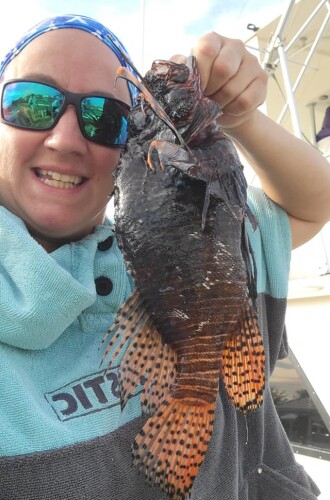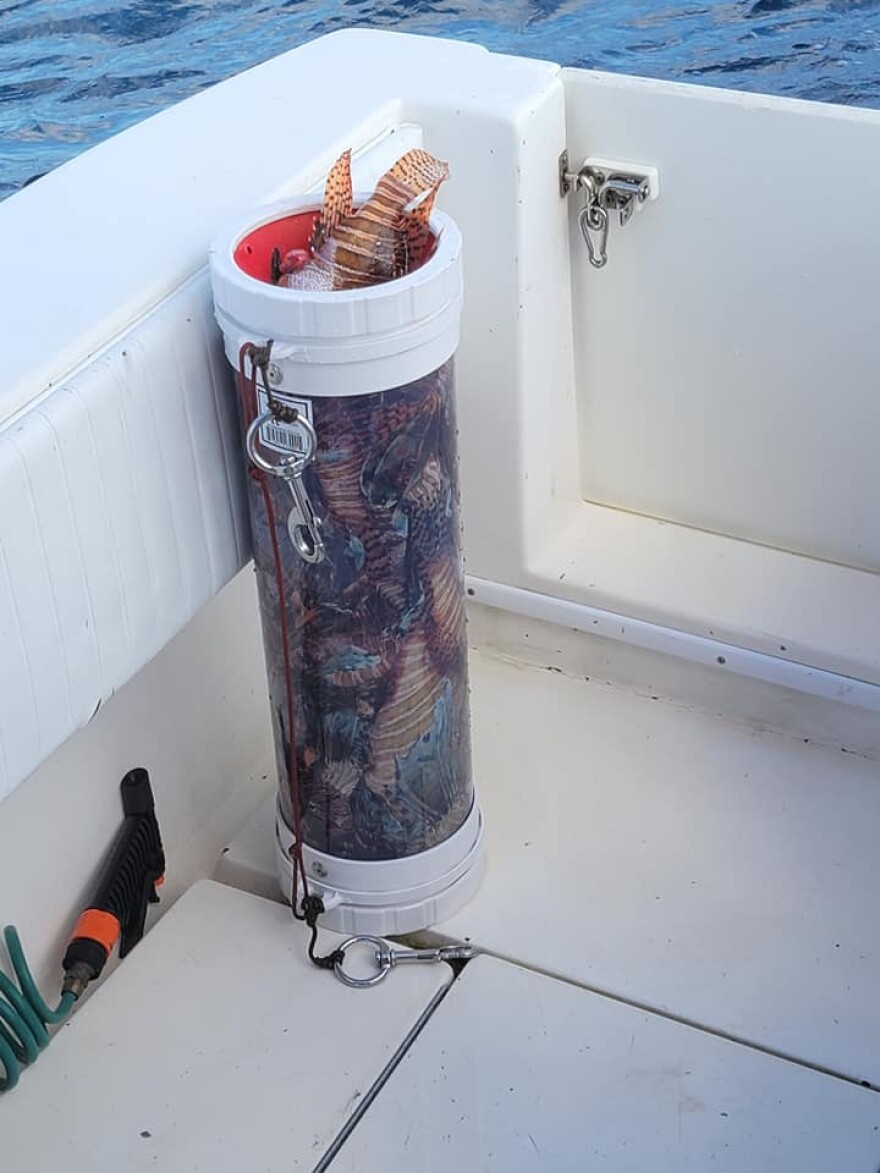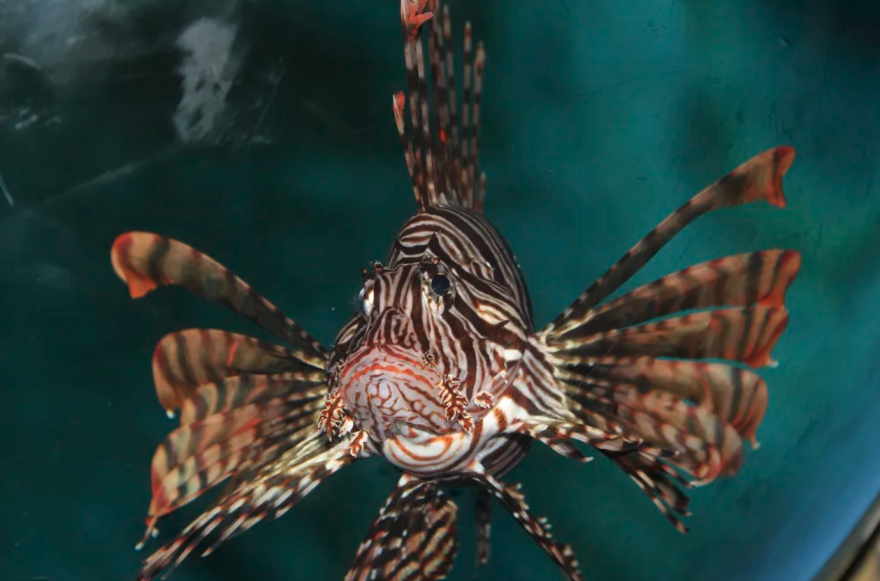When Captain Cindy Garb and her passengers set out on a lionfish hunting expedition off the coast of North Carolina, they load up a boat with silver nitrox-filled scuba tanks, three-prong paralyzer tip spears, puncture-resistant gloves, and clear plastic tubes.
It’s no ordinary fishing gear because these are no ordinary fish. Lionfish are invasive predators covered in 18 venomous spines that pierce the skin and inject a painful neuromuscular toxin.
Covered in deep-red stripes, fluttering spines and regal white tails, the lionfish looks like it belongs in a tropical ecosystem rather than an ocean ledge off the Carolina coast.
“While they do look pretty and they're cute in a fish tank, they’re deteriorating our reef systems by eating absolutely everything that comes near them that can fit into their mouth,” says Garb, who is also a licensed captain, scuba instructor, commercial fisher, and president and CEO of Instigator Fishing and Diving charter company that operates out of Swansboro, N.C.
The state is the upper-most year-round limit of the Atlantic lionfish invasion. This voracious species feeds on the juveniles of commercially important fish like grouper and snapper. At this northern frontier, researchers and divers like Garb are finding creative ways to tackle the predator’s spread.Origin story of an invader

Lionfish are native to the waters of the South Pacific and Indian oceans. Their elegant aesthetic has long made them a popular fish for home aquariums.
The first official documented lionfish sighting was off the coast of Florida in 1985. And for decades, the dominant theory was that the Atlantic invasion started when lionfish spilled or were released from a Florida aquarium.
Now, a new 2021 study led by the U.S. Geological Survey Wetland and Aquatic Research Center that analyzed the genetics of invasive lionfish pokes holes in that original story and raises new theories about their origin. The researchers suggest lionfish might instead have been first introduced in North Carolina or the Bahamas, or potentially all three places.
Wherever they first came from, they have now colonized waters spanning more than 1,500 miles from the Atlantic to the Gulf of Mexico to the Caribbean.'Trash truck of the sea'
To target as many lionfish as possible in one day, Garb and her fellow divers head a couple of hours offshore. The venomous creatures tend to linger by the calm waters of shipwrecks or ocean ledges. When divers reach about 90 feet below the surface, plump lionfish come into view.
“These things are eating everything that comes at them,” Garb said. “They are the freakin' trash truck of the sea down there.”
Lionfish are carnivores that feed on crustaceans and other fish. A single lionfish can eat 5,000 native animals per year, according to NOAA researchers. Garb describes their eating technique like watching a “whale shark feed on plankton.”
In a conversation from 2017, Diving Safety Officer Shawn Harper with the North Carolina Aquarium on Roanoke Island told WUNC that the over-eating habit of these fish was evident.
“Some of these fish that we collected, you can see all the visceral fat inside their body cavities. I mean these fish are actually obese, which is not something you see when you collect local species,” said Harper.
Explorers with the National Oceanic and Atmospheric Administration, or NOAA, recently got a fresh sense of the extent of the lionfish explosion in North Carolina. On a May dive to explore the E.M. Clark, a tanker sunk by a German U-boat during WWII’s Battle of the Atlantic, researchers took in an “unsettling” sight.
“Every square foot of it is covered with the lionfish," said a researcher, describing the scene on the 500-foot wreck in a video of the dive posted to Facebook. "I’ve never seen anything like this.”
This new video of the wreck that sits on the ocean floor in the Graveyard of the Atlantic is helping to answer the question of what the invasion looks like in deep waters off the North Carolina coast.
Invasion has slowed in some areas; deeper waters hold questions and concerns
Steve Gittings, the chief scientist for NOAA’s Office of National Marine Sanctuaries, says there are a few lionfish invasion trends experts are observing that are prompting both confusion and questions.
In most sites off the Atlantic Coast, it seems the lionfish rates may have already peaked.
“There are quite a lot of reports and places with lionfish in less abundant numbers than they were just a few years ago. And there's a lot of questions as to why that is,” says Gittings.

But in deeper waters, researchers are observing a different trend. Gittings added: “There are also a lot of people saying, ‘But if you go down in deepwater … they're bigger, and they're more of them'.”
Experts are exploring whether the lionfish are migrating to deeper water. Gittings says NOAA is currently studying tagged lionfish at the Flower Garden Banks National Marine Sanctuary in the Gulf of Mexico to try to better understand that potential movement.
What is evident, Gittings says, is that “the deeper you go, the bigger they are.” Lionfish in shallower waters are being hunted more regularly, while the fish in deeper waters — like in North Carolina’s natural and artificial reef systems — may have more time to plump up and feast on juvenile fish.
Gittings says researchers know little about the impacts lionfish are having in deep waters.

“My concern [is] ecosystem-level impacts, but ultimately, down the road an impact that becomes evident in the commercial fishing harvest levels. And it'll make fishing for those species less sustainable,” he says.
Garb says she already sees an impact on commercially important fish. If the lionfish spread continues, and they devour more juveniles, it will threaten the financial stability of Garb and other fishers.
“These babies aren't able to grow up to be adults because they're all getting eaten as soon as they hatch. So we need to get rid of these fish,” she says.
Garb knows that full elimination of the species is unrealistic at this point in the invasion. But she and others are eager to at least reduce their populations.
Solutions for the scourge: Hunting parties and lionfish-sucking vacuums
Along the Atlantic Coast, divers, researchers and conservationists are concocting creative ways to suppress the lionfish invasion.
Shawn Harper says that when he first started diving in North Carolina about six years ago, he saw the need for a lionfish mitigation project. He organized conservation hunts with aquarium staff and volunteer divers. The pandemic slowed those efforts, but he says the group hunts did seem to have an impact.
“We did see reduced numbers and we are also seeing reduced sizes in the fish that we were collecting,” says Harper. “Just from an observational standpoint, it did seem to show more life [of other species] on the wrecks.”
During a one year break in hunting efforts due to the pandemic, Harper says he then saw a slew of lionfish return. Harper recognizes that lionfish hunts need to be consistent. He thinks implementing a new system like Florida’s that allows recreational divers to easily sell lionfish for consumption would encourage some of that hunting.
As pandemic restrictions wane, Harper is eager to return to more regular lionfish control dives. He says the North Carolina Aquariums went through a “big revamp” of their conservation programs and their lionfish removal program was recently refunded.
“If we keep going, you know, in the next few years, I think we will see smaller and smaller numbers that we're collecting on each dive as well as smaller fish,” he says.
The state Division of Marine Fisheries encourages fishers and divers to catch and kill as many lionfish as they can, but there is no formal management plan. That leaves a large gap for non-profit groups and individuals to fill.

Harper also sees value in lionfish derbies or rodeos, a territory that Cindy Garb is venturing into herself. Lionfish derbies — popular in Florida and the Caribbean — are tournaments that combine an organized hunt with social events like a cook off. Garb is organizing her first tournament series this summer, culminating in a battle of the champions on September 24.
When done right — over a large area with many participants — they seem to help cut down lionfish populations.
Nicola Smith, a marine ecologist working with the Institute for the Oceans and Fisheries at the University of British Columbia and an expert on invasive marine species, agrees that large-scale tournaments hold promise.
“I feel very optimistic about tournaments,” she says. “You can get a lot of lionfish killed in a very short period of time. You also get the positive public outreach effort that goes along with that. And you kill a lot of fish over a large spatial scale, which otherwise is not possible for an NGO or a dive community.”
Smith is also hopeful about another inventive approach. If researchers can design traps that capture lionfish in the deepest waters without scooping up other species, it could fundamentally transform how humans harvest the creatures. Gittings is personally taking on that challenge. He is working to develop and test mechanical traps that rest on the ocean floor.
“I developed this hemispherical looking thing, it looks like a taco and when it hits the bottom it just opens flat on the bottom. And it exposes a piece of plastic that sticks up into the water column. And then when you close the trap, it closes around any fish that have accumulated next to it,” says Gittings.
The traps are not baited, but lionfish are attracted to structure — which is why they are so fond of the wrecks in the Graveyard of the Atlantic. Gittings says the traps don’t seem to scoop up many other fish, but they are seeing success with lionfish in experimental testing. The trap is now undergoing commercial tests in the Florida Keys with the Reef Environmental Education Foundation.
Beyond mechanical traps, inventors are also testing out electronic solutions to the lionfish problem. Including a lionfish-sucking vacuum developed by Colin Angle, the cofounder of Roomba-maker iRobot. Angle says he encountered lionfish face-to-face on vacation in Bermuda a few years back and was inspired to take action. His team developed The Guardian: an underwater lionfish-sucking vacuum.
The goal is to go beyond the depths humans can dive. The team behind The Guardian say they’ve created three versions so far, and they’re continuing to improve the technology. Gittings says eventually, nature will contribute some of its own defenses in the fight against invasive lionfish through population-reducing diseases, parasites or predators. But for now, Gittings says, “the average citizen is still the best defense against lionfish.”
“Those divers out there with those tri-tip spears are the ones we're counting on to keep populations low enough,” he says. “It's lots of people out there searching, catching, eating lionfish. … they are quite good fish. I've got a bunch in my freezer that, now that you got me hungry for lionfish, I might have to smoke some up this weekend.”
WUNC's Elizabeth Friend, Lindsay Foster Thomas, and Will Michaels contributed to this report.
Want to learn more about lionfish and other species? CREEP is a podcast about creatures invading our space, and changing the world around us, presented by WUNC and the North Carolina Museum of Natural Sciences. Listen and subscribe wherever you get your podcasts.







